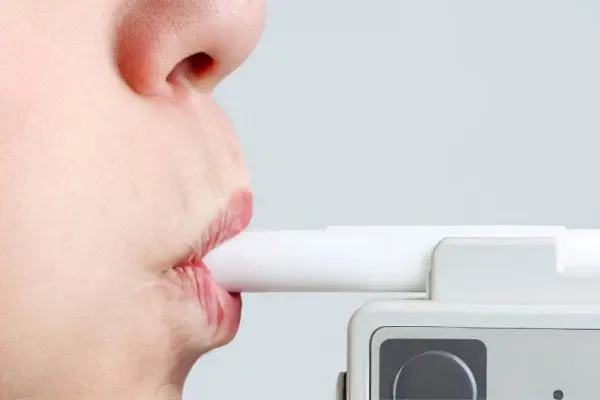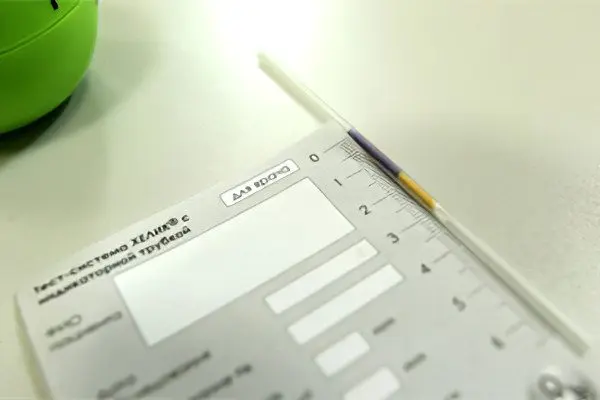Contents
- Testing for Helicobacter pylori
- The essence of the respiratory urease test for Helicobacter pylori
- Preparation for the procedure
- How is the urease breath test performed with carbon-labeled urea?
- How is the 13C urease breath test performed?
- How is a helic test performed to detect Helicobacter pylori?
- Interpretation of the results of a breath test for Helicobacter pylori
- What if the test is positive?
- Rapid tests for Helicobacter pylori

Timely detection and destruction of a bacterium such as Helicobacter pylori in modern medicine is considered a priority in terms of preventing serious diseases of the digestive system (stomach cancer and stomach ulcers). The complexity of diagnosis lies in the fact that in many regions of the country, non-invasive methods that allow to establish the fact of infection are simply not available to the population. While treatment without a diagnosis confirmed by laboratory methods is prescribed everywhere. This entails an unreasonable selection of antibiotic therapy and an increase in bacterial resistance to it. Therefore, it is a qualitative test for Helicobacter pylori that is so important, which allows to establish the fact of the presence of bacteria in the human stomach.
The Helicobacter pylori breath test is a non-invasive method for detecting infection in the air exhaled by a person. A study is carried out using a specialized respiratory test system. It is used for the primary detection of bacteria, to control the treatment and assess the degree of its effectiveness.
In general, the study comes down to taking the air that a person exhales into a test tube or tube. Fences are carried out before taking the loading solution and after taking it. Then the diagnostician evaluates the results, determines the degree of infection with the bacterium based on its urease activity. Therefore, this type of study is also called the urease breath test.
Testing for Helicobacter pylori

The bacterium Helicobacter pylori is a Gram-negative, spiral-shaped pathogen that inhabits the antrum of the stomach and intestines. The waste products of the bacteria lead to the fact that the mucous membrane of these organs of the digestive system will become inflamed, ulcers and erosion will appear on it. In the future, if left untreated, this will lead to the development of diseases such as gastritis, stomach ulcers and even stomach cancer. For the discovery of this bacterium, two scientists (Robin Warren and Barry Marshall) received the Nobel Prize.
Helicobacter pylori can be transmitted from one person to another when kissing or when using common household items. Therefore, for the first time, the bacterium enters the body most often in childhood. The acidic environment of the stomach is not able to destroy the microorganism, since it has its own defense mechanisms against it.
Sometimes the disease begins its development immediately after the infection has occurred, and sometimes after a certain time interval. Often, a bacterium can exist absolutely asymptomatically in the body for several years and shows its activity only as a result of a combination of certain factors, for example, after suffering stress or against the background of a sharp decrease in immunity.
A test for the presence of Helicobacter pylori should be done for those people who have symptoms of disorders in the functioning of the digestive system, among them:
Frequent burps.
Heartburn with sour discharge.
Hiccups.
Bad breath against the background of the health of the oral cavity itself.
Pain in the stomach, feeling of discomfort.
Violation of the stool, while diarrhea can be replaced by constipation.
Symptoms indicating a failure in metabolic processes: hair loss, dry skin, increased fragility of nails.
Rapid saturation with small portions of food, disturbances in its digestion.
Meat intolerance.
If a person has any of the above signs, he should be tested for Helicobacter pylori. Also, all family members should be subjected to research, provided that this bacterium was found in one of them.
The essence of the respiratory urease test for Helicobacter pylori

The breath test is based on the ability of bacteria to secrete a special enzyme – urease. It is necessary for Helicobacter pylori so that the human gastric juice does not destroy its shell.
In the stomach, urease breaks down urea into ammonia and carbon dioxide. The gas is released into the environment. That is what the analyzer catches.
There are several types of urea breath test for Helicobacter pylori, including:
Breath urease test using isotopically labeled urea. In this case, during the procedure, the subject drinks a solution of urea, which was previously labeled with isotopes.
13C urea breath test. In this case, urea labeled with a stable non-radioactive C13 isotope acts as a loading solution.
Helic test. When conducting a helik test, not urea is used, but a solution of urea.
Regardless of which type of examination is performed on the patient, all of them have a high degree of accuracy.
Preparation for the procedure

Before undergoing a test for Helicobacter pylori, the patient must carry out a number of preparatory measures.
Assign a study no earlier than 3-6 days after taking antibiotics or antisecretory drugs. Also, 5 days before the procedure, painkillers, antacids and NSAIDs should be excluded. If a person takes any medications on an ongoing basis, then he should consult a doctor about this in order to clarify the possibility of the procedure.
At least 3 days before the study, it will be necessary to exclude the intake of alcoholic beverages.
The day before the procedure, you can not eat foods that contribute to increased gas formation. It is recommended to remove potatoes, bakery and confectionery products, cabbage, peas and beans from the menu.
On the evening before the study, you need to have a light meal for dinner. Eating should take place 2-3 hours before bedtime.
In the interval between the study and the last meal, at least 6 hours should pass. The procedure is performed on an empty stomach.
It is forbidden to eat in the morning, you should refrain from using chewing gum.
You cannot smoke before the procedure. It is necessary to give up tobacco 3-4 hours before the procedure.
Before testing, you should brush your teeth and rinse your mouth.
You can drink water for the last time an hour before the study, but its volumes should not exceed 100 ml.
If you follow all the suggested recommendations, then the test result will be as reliable as possible.
How is the urease breath test performed with carbon-labeled urea?

The procedure begins with the patient being asked to breathe through a tube. It is located deep in his mouth, the oral cavity itself will be slightly ajar. You need to breathe calmly and smoothly. The doctor at this time takes two air samples.
Then the patient is offered to drink a solution of urea labeled with isotopes. After 15 minutes, another 4 air samples are taken. Care must be taken to ensure that the saliva of the test subject does not get into the tube. To do this, he can take it out from time to time and smooth out the accumulated liquid. If it so happened that saliva still got inside the sample, then the test should be stopped and repeated after an hour. Although modern devices make it possible to protect air samples from saliva entering them.
How is the 13C urease breath test performed?

It is the 13C-urease test that is the most commonly used study to detect Helicobacter pylori. During the procedure, only two air samples are taken from the subject.
The first sample is taken in the morning on an empty stomach, and the second sample is taken half an hour after taking a solution of urea labeled with a stable C13 isotope. A person exhales air into disposable bags that are specially designed for this procedure.
This type of research has a number of advantages, including:
The diagnostic accuracy is high, reaching 100%.
The procedure is safe for health, since no radioactive substances are used during its implementation.
The study does not take long. In general, 40 minutes is enough to complete it.
How is a helic test performed to detect Helicobacter pylori?
The helik test is carried out according to the same scheme as the 13C-urease breath test. The only difference is that instead of isotopically labeled urea, a person receives a solution of urea. Air is taken in 2 samples: before taking the solution and after taking it.
The undoubted advantage of the study is its complete safety for human health. This is the best test for detecting Helicobacter pylori in pregnant women and children. However, some experts question the accuracy of the results obtained. Therefore, the helik test is carried out only in Russia.
Interpretation of the results of a breath test for Helicobacter pylori

A breath test can give two results: positive or negative. The patient either has Helicobacter pylori in the body, or there was no infection.
Also, using a special device called a mass spectrometer, determine the quantitative values of Helicobacter pylori in the body.
The received data can be interpreted as follows:
If the stabilized isotope in the exhaled air contains from 1 to 3,4%, then the degree of infection is mild.
With an isotope concentration in the range of 3,5-6,4%, they speak of an average degree of infection.
Indicators of 6,5-9,4% will indicate a severe degree of infection with Helicobacter pylori.
Values greater than 9,5% indicate an extremely severe degree.
As a rule, the accuracy of the test is not in doubt. It is possible to obtain a negative result only if the conditions for preparing for the study are not observed. Some drugs can reduce the activity of gastric juice production, which will lead to the impossibility of splitting urea.
Test results will be available 1-2 days after the test. The sample storage period is 10 days, but no more.
What if the test is positive?

If the test for Helicobacter pylori turned out to be positive, then the patient will need to undergo a comprehensive examination of the digestive system. The patient must be sent for FGDS, which will provide information about the state of the stomach and duodenum. He will also donate blood for biochemical and general analysis, other studies may be required.
Helicobacter pylori requires treatment. Depending on the severity and nature of the lesion of the inner wall of the stomach, a therapeutic regimen is selected. However, antibiotics are always used to eliminate the bacteria, which are combined with proton pump inhibitors. In this case, two antibacterial drugs will be prescribed. It can be Amoxicillin, Levofloxacin, Metronidazole, Clarithromycin, etc.
During the course of treatment or after its completion, the doctor may suggest that the patient once again do a test for Helicobacter pylori. This is required to monitor the effectiveness of ongoing therapy or to evaluate the treatment already performed. A gastroenterologist deals with the treatment of diseases of the digestive system.
Rapid tests for Helicobacter pylori

To determine the presence of pathogenic flora, there is no need to go to the laboratory. At the pharmacy, you can purchase rapid tests that are intended for home use. With their correct application, the reliability of the results reaches 100%.
There are two types of rapid tests, the biological material for which is blood or feces.
To perform a test for the detection of Helicobacter pylori in the blood at home, you will need to follow the following algorithm of actions:
Wash your hands thoroughly, treat them with an antiseptic solution.
Remove all dough components from the packaging, lay them out on a clean and dry surface.
Treat the finger with a tissue for injection.
Open the scarifier that comes with the test and make a small puncture on your finger so that blood comes out of it.
By pressing on the finger, it is necessary to collect a small amount of blood into a pipette. It also comes with a test kit.
A drop of blood is applied to the window, which is located on the test itself. 2 drops of the reagent are injected into it.
Leave the test on a flat surface for 15 minutes.
The result can be interpreted after the specified time. If one band appears in the indicator, then the test is negative, and if there are two bands, then the test can be considered positive.
To test for Helicobacter pylori by stool, you will need to collect a small amount of feces in a clean container. You should not take laxatives before the study. The material is collected with a cotton swab. To conduct a study, 125 g of feces is enough, which is placed in a test tube. Then the reagent is injected into it. The tube is shaken to obtain a uniform consistency. The material is kept for 10 minutes, after which a small amount is applied to the test strip. Wait another 10 minutes. After this time, evaluate the result. If one strip appeared on the test, then it can be considered negative, and if two strips, then positive.
It is worth taking into account that the doctor will not review and evaluate the results obtained at home. Also, based on them, it is impossible to prescribe treatment. Therefore, if you suspect infection with Helicobacter pylori, you need to contact a specialist, undergo professional diagnostics and receive adequate treatment for the disease.









